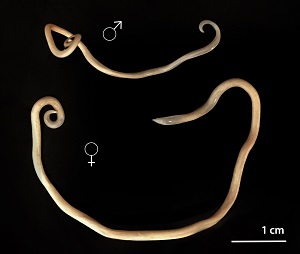What is Toxocara Canis?
Toxocariasis is an infection caused by tiny roundworms (also known as nematodes) that mainly affects people living in tropical and subtropical regions, often those from lower socioeconomic backgrounds. Even though it’s not frequently serious, it can sometimes lead to severe complications like blindness or serious brain inflammation.
The issue stems from two main species of Toxocara, named Toxocara canis and Toxocara cati. Animals like cats, dogs, foxes, coyotes, and wolves can carry these nematodes in their gut, and the eggs get passed out in their poop. These eggs can stay infectious for years outside the host animal. When other animals, including cats, dogs, rabbits, and birds, eat the cysts, the eggs hatch and move to various muscles and organs, where they create encysted parasites. Wild carnivores can get the parasites by eating infected meat, or simply by eating soil with the eggs in it. The parasites can also be passed on from mother animals to their babies before birth. Humans can fall prey to these nematodes too, just like a number of animal hosts.
The disease in humans occurs when the parasites move through tissues in the body apart from the gut. In fact, a common type of toxocariasis, called visceral larva migrans, usually happens in children as they often play in areas with contaminated soil.
What Causes Toxocara Canis?
Clinical Toxocariasis is a condition that’s caused by a species of worm called Toxocara traveling through the body. There are two kinds of these worms: Toxocara canis, which mainly infects canines (like dogs, foxes, and wolves), and Toxocara cati, which mainly infects felines (like cats). However, T. cati is thought to cause more serious illness in human beings.
Children are more likely to get infected with these worms. This is because they might swallow the worm eggs found in soil or other substances contaminated with this worm, through interaction via the mouth, otherwise called the fecal-oral route.
Research has found that public parks with sandboxes used by everyone often carry high amounts of these worm eggs, making children who play in these areas more prone to picking up an infection.
Risk Factors and Frequency for Toxocara Canis
Toxocara, a type of parasite, is common worldwide, especially in areas with many domestic dogs and cats. It mostly affects children in tropical and subtropical areas. The disease is more common in developing countries, with over 80% of children in parts of Nigeria being affected. However, in the United States, only about 5 to 15% of people have the disease, with around 10,000 clinical cases being diagnosed every year.
Risk factors for catching this disease include poverty, higher latitude, contaminated soil, young age, and a high population of dogs and cats. These factors explain why the disease is more common in developing countries compared to developed countries.
- Toxocara is common worldwide and is found in large numbers where there are many domestic dogs and cats.
- It mostly affects children in tropical and subtropical regions.
- The disease is more prevalent in developing countries. For instance, over 80% of children in parts of Nigeria are affected.
- In the United States, the disease is found in about 5 to 15% of the population, and approximately 10,000 clinical cases are diagnosed each year.
- Risk factors for contracting the disease include poverty, high latitude, contaminated soil, young age, and high number of dogs and cats.
- These factors cause a higher prevalence of the disease in developing countries compared to developed countries.
Signs and Symptoms of Toxocara Canis
Ocular larva migrans (OLM) is a condition caused by tiny worms migrating through the back of the eye. It’s a top cause of blindness in kids in developed countries. Kids, usually between five and ten years old, experience it as vision loss in one eye. Depending on where the worm sets up shop, the child’s eye examination might show uveitis, retinitis, choroiditis, or endophthalmitis. In some cases, this can also lead to secondary glaucoma. On a cellular level, they can have small abscesses filled with white blood cells associated with allergies or infection, surrounded by granulomas, or inflamed tissues.
Visceral larva migrans (VLM) happens when these worms travel not only through solid but also hollow organs in the abdomen. Symptoms to look out for in children would be fever, nausea, vomiting, stomach pain, and unusually high levels of white blood cells. Medical examination might point to an enlarged liver and spleen, which could mean that the child’s illness is not only a simple stomach bug. If the worms get into the lungs, it could lead to bronchospasm, a sudden constriction of the muscles in the walls of the bronchioles, and wheezing.
Lastly, although rare, these parasites can invade the central nervous system leading to diseases ranging from eosinophilic meningitis to severe inflammation of the brain and its lining, leading to seizures, encephalopathy (a disease that alters brain function), or even mental health symptoms.

Testing for Toxocara Canis
Diagnosing toxocariasis, a type of parasitic infection, can be quite challenging. The most reliable way to diagnose it, known as the ‘gold standard’, is by identifying the parasite under a microscope. However, this is rarely done due to practical reasons. Instead, a type of blood test called ELISA assays is often used. Unfortunately, these tests may miss the infection about 20% of the time because they’re not perfectly reliable.
Finding the parasite in stool samples is not effective because humans are not the main host for Toxocara – the parasite that causes toxocariasis. There are other signs of infection like an increased number of a particular type of white blood cell called eosinophils, and a higher level of certain proteins in the blood (hypergammaglobulinemia). However, these signs are also common in many other conditions and are not exclusively linked to toxocariasis.
Since the tests available are not perfectly reliable, doctors sometimes have to make a diagnosis based on symptoms and the overall clinical picture. In some cases, they may decide to start treatment even if they are not 100% sure it’s toxocariasis, especially if the patient’s symptoms and medical history suggest it’s the most likely diagnosis.
Treatment Options for Toxocara Canis
To treat a condition known as Viseral Larva Migrans (VLM), two types of medication, albendazole and mebendazole, are commonly used. However, albendazole is often preferred because it is more effective at reaching the affected tissues. Depending on your individual health condition and the types of infections common in your area, other medications like ivermectin and diethylcarbamazine (DEC) might be useful too.
If you have Ocular Larva Migrans (OLM), it’s a bit more difficult to treat. The main goal is to reduce inflammation in your body. So, you might be prescribed prednisone, which is a medication that helps decrease inflammation, together with the above antiparasitic medications. In the most severe cases where medication cannot manage the condition, surgery may be considered.
What else can Toxocara Canis be?
When diagnosing VLM (Visceral Larva Migrans), a condition that often results in fever and a high white blood cell count (eosinophilia), physicians would consider other conditions that can cause similar symptoms. These may vary depending on where in the world the patient is located. The possibilities they might consider include:
- Ascariasis (Löffler syndrome)
- Trichinosis
- Strongyloides
- Onchocerciasis
- Schistosomiasis
- Paragonimus
- Entamoeba histolytica
- Fasciola hepatica
When it comes to diagnosing OLM (Ocular Larva Migrans), a key alternative condition to rule out is retinoblastoma, a form of eye cancer. This disease was actually first noticed in the mid-20th century during examinations of eyes that had been removed due to suspected retinoblastoma.
Finally, in cases of eosinophilic meningitis (an inflammation of the membranes surrounding the brain and spinal cord), the principal alternative diagnosis to consider is an infection caused by Angiostrongylus, or rat lungworm.
What to expect with Toxocara Canis
The outlook for Visceral larva migrans (VLM), a disease caused by parasites affecting various organs in the body, is usually positive. However, long-term VLM could be linked with epilepsy, a neurological disorder where brain activity becomes abnormal, and cognitive delay, a condition where a child’s intellectual and social abilities develop slower than usual. In some cases, children might even lose their sight.
Additionally, there have been reports of other complications associated with VLM. These include myocarditis (inflammation of the heart muscle), pneumonia (infection that inflames the air sacs in one or both lungs), and Henoch-Schönlein purpura (a disorder that causes inflammation and bleeding in the small blood vessels).
Possible Complications When Diagnosed with Toxocara Canis
Although it’s uncommon, the complications associated with the mentioned condition could be quite serious. These can range from loss of sight, serious neurological diseases, to even death in rare instances.
Potential Risks:
- Loss of sight (Blindness)
- Severe neurological diseases
- Potential death
Preventing Toxocara Canis
It’s important to understand that toxocariasis, a disease caused by a roundworm infection, is typically spread when people accidentally ingest traces of animal feces. As such, it’s crucial to teach good hand hygiene practices to reduce the risk of getting this disease. It’s also helpful to be aware of the other risk factors, such as being around pets or areas where animal feces may be present, like sandboxes.
However, a common problem among healthcare workers is overlooking this disease in children. We likely don’t know the true extent of how many people are affected by this disease, but we know that failure to diagnose it can lead to long-term problems and can result in significant costs related to maintaining a patient’s health. It’s helpful to remember, though, that most of these issues are preventable with good hygiene and awareness of the risks.












